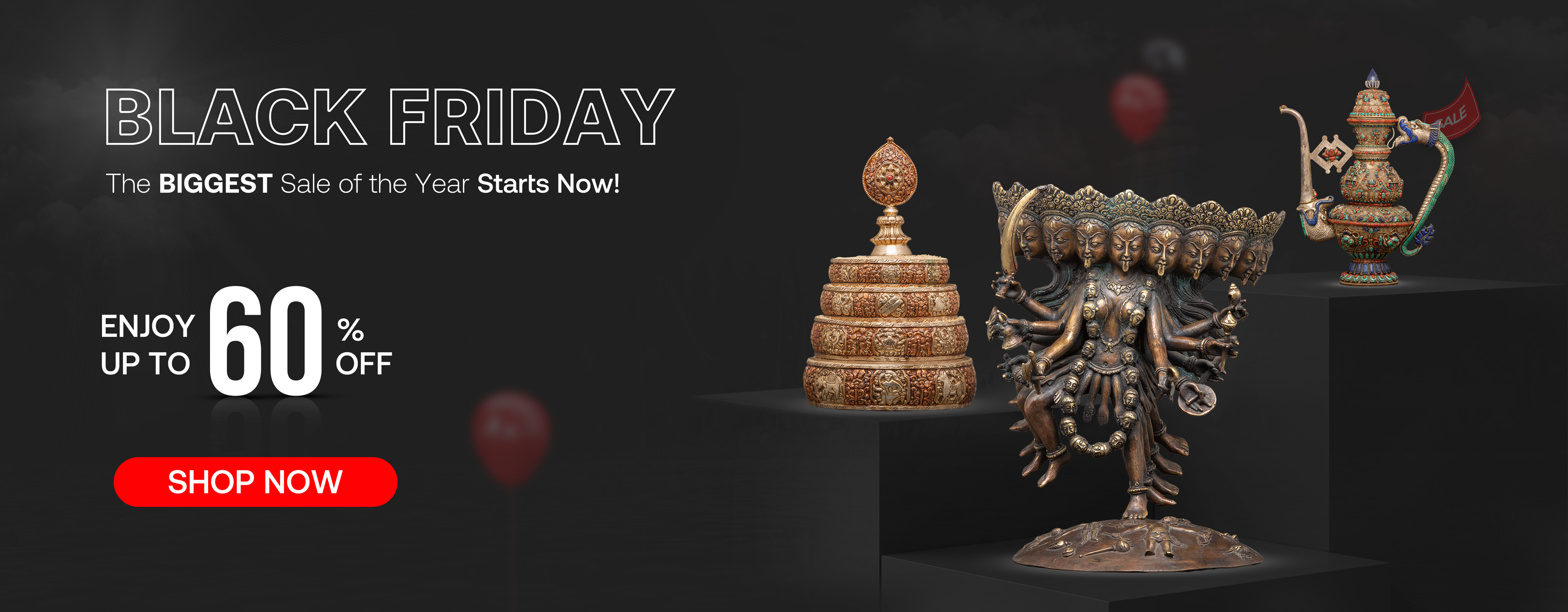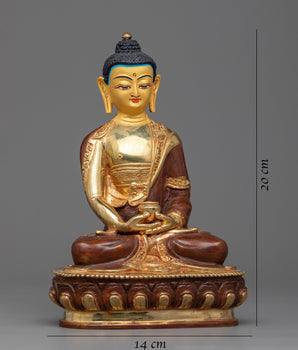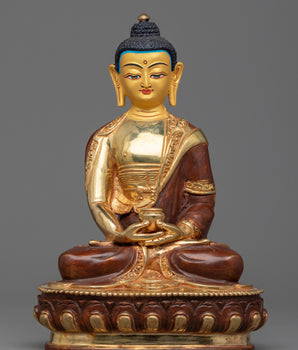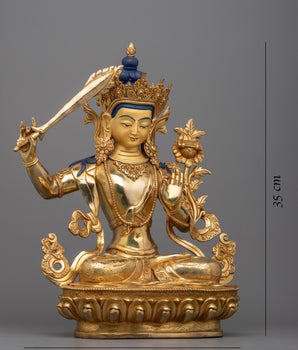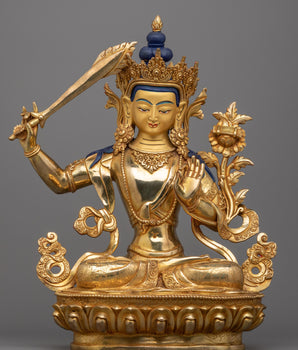The Cultural and Spiritual Significance of Dalucha
Dalucha, also known as Akashdeep, which translates to "oil lamp" in English carries the history of Kathmandu within itself. In addition to representing light, this traditional oil lamp honors Nepal's artistic and spiritual heritage and is still commonly seen hanging outside homes, temples, and monasteries. The flicker of flame inside this oil lamp carries the history of Kathmandu's founding through the generations of the Newar Buddhist and Hindu communities. In both Buddhist and Hindu traditions, lighting an oil lamp symbolizes the actual and symbolic eradication of darkness.
Often found hanging outside of houses and prominent during rituals, prayer, and offerings, a Dalucha lies between the cosmic and terrestrial planes. The significance of flame in the form of these oil lamps, which stands for knowledge, divinity, and consciousness, is one of the primary elements of its ceremonial initiation. A Dalucha is more than just an accessory; it is a representation of devotion, faith, spirituality, and even Nepalese craftsmanship that has persisted from ancient times to the present.
Dalucha in Newar Buddhist and Hindu Traditions

More than just a lamp or light, the oil lamp is an offering to the Buddhas and Bodhisattvas in Newar Buddhist traditions. In addition to representing the defeat of ignorance and the pursuit of enlightenment, lighting lamps as part of this ritual also represents the development of merit and the cleansing of the body and mind. Oil lamps do represent lights and good triumphing over evil and darkness during Hindu holidays like Tihar (Deepawali), which further relates to the larger theme of spiritual renewal.
Lighting the Dalucha during prayer and worship is a powerful physical and symbolic act of devotion. It is an act of asking the deity for blessings and intervention, representing a person's dedication of their life as well as the lives of all those who pray or contribute to the deity's worship. Light is frequently associated with spiritual knowledge and divine wisdom in both Buddhist and Hindu texts. During a ritual or ceremony that specifically claims to obtain divine blessings and divine fulfillment, lighting the oil lamp also functions as a symbolic act of divine communication.
The History of Dalucha Lamps
The oil lamp dates back to the ancient Newar civilization of the Kathmandu Valley. These lamps are representative of the Kathmandu Valley's long-standing tradition of metal working, an art which has been developed by many generations. It arguably stands out as the most significant object in that lineage, witnessing Nepal's religious, cultural, and artistic history.
The Mythological Origin of Dalucha Lamps
As per the ancient Newar oral tradition, Kathmandu was one large, peaceful lake. In the middle of that lake existed a light eternal, arising from a lotus flower. This everlasting light embodied a divine presence that lit the entire valley. It is said that Manjushri, the Bodhisattva of Wisdom, drained the lake and cut out the gorge at Chobhar so the valley could be a inhabited place. However, the divine light did not leave; it changed into the essence of everlasting wisdom and divine guidance to the valley's people.
Dalucha oil lamp signifies this mythic, as the flame itself has always been viewed as a sacred everlasting light that once illuminated the Kathmandu Valley. Therefore, the lamp is a vital connection to the history and mythology of the valley and the essence of spirituality in the region of Kathmandu. When people light this oil lamp, they are keeping alive a connection to a light of wisdom and divine energy that exists in the valley to the present.
Evolution Through Dynasties and Religious Influence
The history of the lamp is not just a reflection of one era but an evolution that mirrors the shifts in Nepal’s cultural and spiritual landscape. Over centuries, different dynasties played a crucial role in shaping the design and significance of these oil lamps. Through the ages, the lamp developed a distinct appearance, meaning, and role, influenced not only by culture, but often by the drifts of different dynasties.
The Licchavi period (400–750 AD) was attended by the merging of Hinduism and Buddhism, and both these religious notions shaped the lamp's evolved design and significance. The Licchavi period can also be referred to as the first period that introduced spiritual meaning into daily objects beyond simply being material goods of a culture. Thus formalizing the Dalucha as an object of sacred ritual.
During the Malla period (12th–18th century), metalwork in Nepal evolved. The increase of ritualized metalwork increased demand for hierarchy and ornamentation, and Dalucha in the Malla period became much more elaborate, containing lotus ornamentation and architectural temple designs, etc. The bronze-casting methods introduced greatly added to the artistic and detailed nature of the lamps, evolving them into objects that not only represent religion, but art itself.

Symbolism and Historical Continuity
Even though modernization has occurred, the Dalucha lamp continues to be an important symbol of the Nepalese spiritual and artistic identity. Ancient lamps can still be found in temples, monasteries, and heritage sites being actively engaged in everyday worship or major festivals.
Today, artisans are perpetuating the practice of making these lamps in traditional ways that can keep this timeless heritage a part of the present for generations to come. The lamp continues to be a sacred vessel of light between the past, present, and for a future, as it preserves its identity as a timeless symbol of religious practices and artistic achievement.
The Parts of a Dalucha Lamp
The classic oil lamp consists of numerous intricately crafted pieces each with a distinct function and meaning.

1. The Bowl (Reservoir): This is the principal vessel that holds the oil and is typically made of brass or copper. The bowl often has intricately carved representations of deities or religious symbols. The oil signifies the water that previously filled the Kathmandu Valley. Thus the oil connects all the way back to the sacred transition of the valley from lake to spiritual center.
2. The Wick Holder: A small, slight elevated section that holds the wick. The flame of the wick signifies the eternal flame, a constant reminder of the spiritual energy that has existed in the valley throughout the centuries.
3. The Base: The foundation of the Dalucha that gives it stability. Some bases are simple and others have elaborate designs and motifs of some sort of Buddhist or Hindu imagery.
4. The Hanging Chains: The chains hanging down below the bowl signify the petals of the thousand-petaled lotus flower thus advocating direct connection between the lamp and its spiritual significance for Newar people in the culture.
5. Ornamental Embellishments: Traditional lamps, often engraved with floral patterns, auspicious symbols, or even images of deities, accentuate the artistic and spiritual value of these lamps.
A Testament to Nepalese Metalwork and Craftsmanship
Dalucha can be considered remarkable proofs showcasing Nepalese art and history, especially the Newar craftsmen of the Kathmandu Valley. The typical decorative patterns of floral devices are coupled with great symbols and exquisite carvings of divine figures, making every lamp an artistic masterpiece
Materials and Crafting Techniques

These traditional lamps are primarily crafted from oxidized copper or brass, which remarkably get older. Each dalucha lamp is a unique piece of art, which is built painstakingly by hand over several days or weeks depending on the level of detail involved in the design. The majority of lamps make use of the lost-wax casting technique to create these remarkable pieces.
Besides being a hallmark of glorious Nepali art, these exceptional lamps are also a proof of devotion and spiritual love that goes into each lamp. They vividly tell the story of faith and tradition through engravings, embellishments and exquisite carvings.
Dalucha in Daily Rituals and Meditation
The lamp is central to both everyday rituals and unique meditative practices for ease of the Newar people. For instance, families begin each day by lighting the lamp, offering the day a divine blessing and protection. These lamps offer more than just light in meditative practice—they create a space of serenity and spiritual focus. The Trataka technique, where a practitioner focuses on a single point of light, is said to increase concentration and improve mental clarity. In this manner, the Dalucha transcends an oil lamp; it is a vessel for mental and spiritual purification.
Dalucha in Nepalese Festivals and Celebrations
The oil lamp is more than a religious object or cultural heirloom; it actively shares in the most important and sacred moments of the Newar community. During various rituals, festivals, and celebrations, it is a key player, providing a visible source of illumination and contributing to the multisensory spiritual experience of the valley during sacred times. These lamps serve to channel divine energy, to present a physical offering of light for the gods, and to interconnect human embodiment of worship and their spiritual beings.
Use During Jatras and Street Illumination
Jatra, or religious procession, are just one of the many lively and ongoing aspects of the rich cultural and religious life of Kathmandu. During each jatra, the Dalucha is brought out prominently to illuminate the streets and homes of the Newar community. These lamps are often hung outside into their home, attached, displayed, or lit in temples or carried during processes of jatra, transforming darkness into light and signaling divine light.
As the procession of the Jatra begins, the lamps spread a warm, spiritual light on the streets—adding to the sacredness of the space. In celebrations like Indra Jatra and Machhindranath Jatra, the Dalucha lamps illuminate the ground in front of the chariot of the deities as they make their way through the town as a symbol of their spiritual journey through the path of the community. The light guides the devotees serving as a sense of direction and an everlasting testament of the gods’ heavenly presence.

A particularly important aspect of the Indra Jatra festivities occurs the morning after the celebrations when families are expected to light their lamps before beginning the traditional Newar feast, Bhoj Samay Baji. This practice confirms the understanding that spiritual activities must always take place prior to any physical act of nourishment. Guests and family members offer prayers, and it is only with the lamp lit that family members are allowed to begin eating. This practice signals that blessings from divinity must be sought and graciously received before indulging in the pleasures and products of the material world. Since the Dalucha becomes a suitable symbol of divine order, all social gatherings serve as a reminder to practice spiritual discipline, respect, and thankfulness before indulging.
Active Participance in Spirituality
The Dalucha is not merely a passive object in festival celebration. It actively participates in the Newar people's spiritual rituals. Its involvement is significant because lighting the lamp is a way to ask God to bless one's house and neighborhood. Lighting the Dalucha is an act of devotion that physically expresses one's prayers, aspirations, and desires for divine favors. The lamp is a symbol of illumination and safety, and it also serves as a reminder of the everlasting flame of wisdom and the importance of preserving one's spiritual purity during a religious ceremony.
Worship of Dalucha During Yaṃlākī (Full Moon Festival)
One of the most personal and intimate ways that a person engages with the Dalucha lamp is through the Yaṃlākī full moon festival. This is one of the most important holidays of the Newar religious calendar. Yaṃlākī occurs on the full moon in Baisakh, which is a time of renewal and spiritual reflection. The Yaṃlākī celebration marks a time when every household in the Kathmandu Valley observes lighting a Dalucha oil lamp, noting the presence of light, as well as the importance of light to vanquish darkness and receive divine blessings.
It is believed that lighting the oil lamp restores prosperity, protection, mental and spiritual clarity to a household, and symbolizes the triumph of light over darkness. Worshiping the Dalucha lamp is more than lighting a lamp; it provides an opportunity for the participants to celebrate and honor their traditions, ask for divine favor, and acknowledge their ancestors.

The Dalucha rite of the Yaṃlākī isn't understood as an isolated event, but rather one often enacted through deliberate interaction and fostering in the life of the community, passed down and elaborated by families across generations. Each year in Kathmandu Valley, families gather during each full moon to light their Dalucha lamps and thus repeat their ancestors' traditions. The ceremony illustrates the resilience of traditional practices, the living dynamism of Newar culture, and the Dalucha's function as an embodied sacred object in the habitus of the participants.
Dalucha’s Everlasting Glow
The Dalucha oil lamp serves as a vibrant symbol of Nepal's rich spiritual traditions, self-expressive art, and cultural heritage in addition to being a useful object and home accent. The Dalucha has changed over time from being a straightforward source of light to a symbol of divine energy and, ultimately, of the interconnectedness of the material and spiritual worlds. The Dalucha is so vital to the spiritual life of the Kathmandu Valley that it is still used in Buddhist and Hindu ceremonies.
The Dalucha has a vivid capacity to unite individuals and communities through ancestral connection and the reaffirmation of a shared identity. The light of the Dalucha is never merely light, be it a light in the daily rituals, hung in the streets in Jatras, or tended to in care during the celebration of the Yaṃlākī full moon festival. Whether a family lighting, individual mustering, or group community member reflected in the space where the Dalucha burns, the Dalucha represents engaged introspection, spiritual devotion, and collective festivity. If the Dalucha is a sacred object, it is the first place in which people touch the divine and, in turn, touch each other. The Dalucha is a smooth conduit ensuring the light of past generations glows in the present.
The Dalucha has no time as a source of wisdom and enlightenment. The sacred flame of tradition will continue to endure and shine for the spiritual seeker and the curious traveler alike, for it raises the spirit, motivates the attitude, and enlightens the mind, as it will continue to bring such enlightenment to any soul who seeks its light for eternity.





